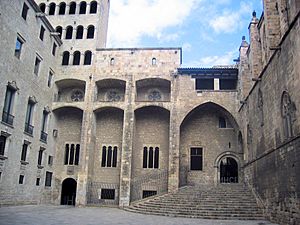Palau Reial Major facts for kids
The Palau Reial Major, which means "Grand Royal Palace," is a group of old, important buildings in Barcelona, Catalonia, Spain. You can find it in a famous square called Plaça del Rei. For many years, this palace was the home of the powerful counts of Barcelona and the kings of Aragon.
The palace is made up of three main parts, each with its own history:
- The Saló del Tinell, a large hall built by King Peter IV between 1359 and 1362.
- The Chapel of St. Agatha, a royal chapel built in 1302 under King James II.
- The Palau del Lloctinent, built in 1549 by the government of Catalonia for Charles V.
Contents
Exploring the Grand Royal Palace
The Palau Reial Major is a fantastic example of old architecture. It shows how buildings were made hundreds of years ago.
The Saló del Tinell
The Saló del Tinell is a grand hall that was built in the 14th century. An architect named Guillem Carbonell led its construction. This hall has beautiful Gothic arches. These arches stand on older stone vaults from the 11th century. Even before that, there was a large building from the Visigoth age on the same spot. Imagine how many layers of history are under your feet!
The Chapel of St. Agatha
The Chapel of St. Agatha was designed by an architect named Bertran Riquer. It was built to be the special chapel for the royal family, replacing an older prayer room. This chapel has a unique octagonal (eight-sided) tower from the early 14th century. Inside, it has one long room with a special ceiling and a polygonal (many-sided) end section. The sacristy, which is a room where sacred items are kept, is built right into the ancient Roman walls of the city.
One of the most amazing things in the chapel is a large painting called an altarpiece. It was made by the famous painter Jaume Huguet between 1463 and 1466. This altarpiece shows the story of the Epiphany, which is when the Three Wise Men visited baby Jesus.
Architectural Masterpieces
Both the Saló del Tinell and the Chapel of St. Agatha are considered masterpieces of Catalan Gothic architecture. This style is known for its tall, elegant structures and detailed decorations. The Epiphany altarpiece by Jaume Huguet is also a very important Gothic painting.
Today, you can visit these parts of the palace as part of the Barcelona City History Museum (MUHBA). Sometimes, special temporary exhibitions are also held there. It's a great way to step back in time and learn about Barcelona's past.
Later Uses of the Palace
After the 16th century, the palace was no longer used as a home for kings. Instead, it was divided up. Part of it was used by the Inquisition, which was a powerful religious court. The other part was used by the royal administration, which managed the king's affairs. During this time, a new door was built that led to the Royal Audience Hall. This door had a triangular decoration above it, called a tympanum. You can now see this tympanum at the entrance of the Museu Frederic Marès.
The Palau del Lloctinent
The Palau del Lloctinent was built between 1549 and 1557 by Antoni Carbonell. It was designed in a style that mixed late Gothic and Renaissance ideas. This building served as the home for the Viceroy (or "Lloctinent"), who was like the king's representative in Catalonia. Also from this period is a five-story tower with a rectangular shape, built in 1555. It is known as the Mirador of King Martin.
Images for kids
See also
 In Spanish: Palacio Real Mayor de Barcelona para niños
In Spanish: Palacio Real Mayor de Barcelona para niños





